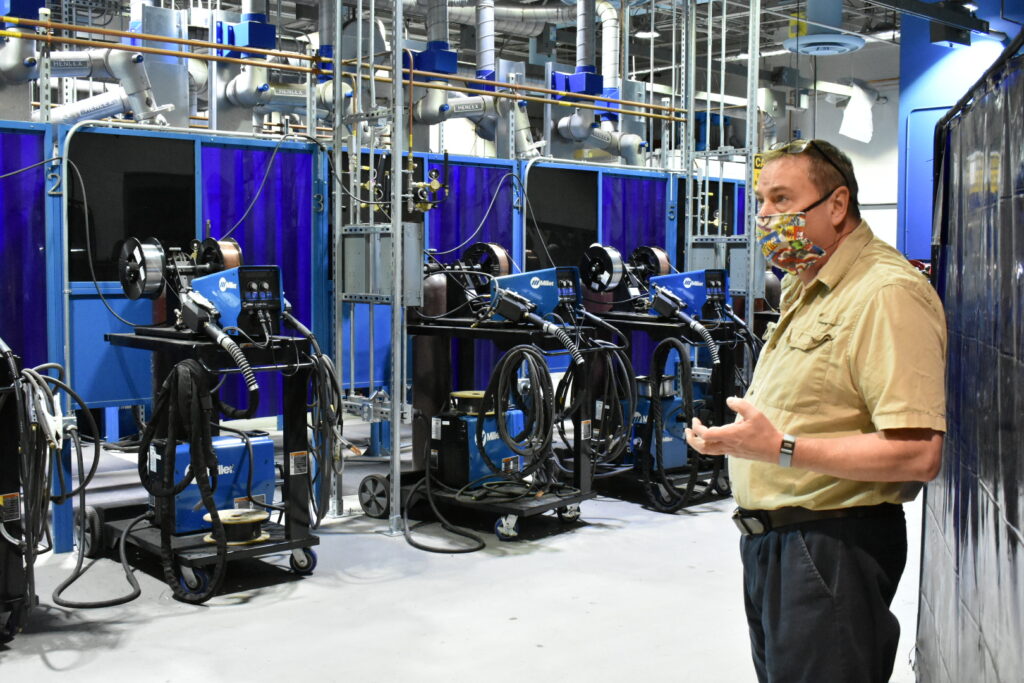Manager of Northampton Community College’s Electromechanical Department, Gary George, talks his career and passion of engineering.
In the vapid office of an electromechanical engineer, the only personality displayed among the eggshell walls and cabinets consisted of three magazine clippings: a picture of Earth from the Moon, a “Life” magazine cover of an astronaut on the Moon aptly titled “To the Moon and back” and a third of a UFO captioned, “I still want to believe.” There was a humming noise to complete the mechanical aura. Was it the sound of heavy machinery being operated? No. It was the eerie buzzing of silent audio channels. Being regulated to the virtual world, my interview with Northampton Community College’s Manager of Electromechanical Technologies Gary George was conducted over Zoom.
I began my introduction before George pointed out I was muted—great start. He lounged back in his chair for most of the interview, a Marvel comic facemask draped around his neck. His face and voice remained monotone as he discussed the inner workings and politics of NCC’s Hartzell Technology Hall. Once he started on his students and filmmaking, he leans forward, talks with energy and a smile on his face. He’s what you would imagine if you had an Uncle Gary: a bit distant, unsure if he liked you or not but you find he is quite warm and caring.
“From the day I started working [at NCC] I thought it would be really cool—you have students for two years—first semester: everyone writes a screenplay and the class decides as a unit which one they like the best. Second semester: [we complete preproduction]. Third semester: go out and shoot the movie. Fourth semester: edit it and have a releasable version of it and then have a screening over in the auditorium here.” His smile fades as he explains that curriculum and red tape bars that from happening.
George graduated NCC’s engineering program before obtaining his Bachelors of Science in Mechanical Engineering from the University of Arizona.

“I landed a job working for the Department of Defense Large Caliber Weapons Lab making 155mm Howitzer rounds that contained nuclear payload—not my favorite cup of tea,” George said as if he was remembering a traumatic injury. “I was raised in a family where we sat around the dinner table and my mom and dad would tell stories about what happened to them at work. I couldn’t talk about what happened to me at work because it was all classified.”
George’s duties were so clandestine that he had to wait to receive clearance before tackling jobs. With his downtime, George “picked up a book called ‘Skywalking: The Life and Films of George Lucas.’ I read that book and I decided right then and there that it was my mission to move out to California and get a job in the film industry because, here’s the big one, I read all of the Martian tales of Edgar Rice Burroughs and I wanted to turn ‘A Princess of Mars’ into a film.”
He wanted his sci-fi adaptation to be his big break in the film industry. “Honestly, I felt that I knew the characters so well and the story so well that I could create an epic film. Got out there, I was naïve, I was young. … It was like, jeez, ‘knock, knock, knock,’ how do I get in the film industry?”
After a series of short-lived engineering jobs in the automotive and defense industries, George was presented an opportunity by his coworker’s church member. George was granted entrance to the film industry, albeit a humble entrance instead of a heavenly one. He began working as an editorial personal assistant at Boss Film Studios, a visual effects company. He learned how to work cameras, splicing film, running film through Moviolas and projection. George also worked with the engineering crew to develop a motion control dolly.
“So, it’s always kind of been a dream of mine to leave the mechanical side [at NCC] and take over doing [film],” George said.
George spoke at an NCC film class NCC to discuss his career, deeming it a “dismal failure.” George rolled his eyes and shook his head before chuckling, “All they did was ask me questions like ‘did you meet this person?’” Despite his perception, he was welcomed warmly. The film professor called George to tell him how much the students loved him and wanted him back for another guest speaking.
His film credits include special effects on films like “The Hunt for Red October,” “Titanic” and “Die Hard.” On “Titanic,” he helped integrate the miniature engine room set in the final composition of the film, George said in an article from NCC’s News Center.
He tries to remember everything with extreme accuracy, working through the most trivial details like an algebraic equation. He uses words like “genesis” instead of “start.” When returning to electromechanical discussion, George returns to his monotone descriptions as if he is trying to mimic the machines he works with.

I asked George about where he sees the future of electromechanics going, using programmable logic controllers as an example. Once bulky, slow and capable of completing one task, PLCs are now microscopic, instantaneous and capable of completing multiple complex tasks. Despite my display of knowledge, George took me through PLCs from start—or genesis—to modern day. His mind is analytical to the most minute detail … I’m sure he could go on a one-hour tangent explaining how to drink from a cup: examine the cup, if filled to the top, gently pick the cup up by the handle. We pick it up by the handle to avoid burning our hands and we do not sip loudly because it could bother others. Did you know that the Ming Dynasty invented hard porcelain teacups while, quite expectantly, the English brought handles to the teacup?
As George explains, his hands work the mechanics through the air. He snaps imaginary plugs into outlets and runs through the motions of invisible machines in what can only be interpreted as engineering sign language.
“He’s very versed on the mechanical side of things, his background is mechanical engineering,” Professor of Electromechanical Technology Robert Wolff said of George. “He has a lot to share and loves to talk.”
As he describes a former Caribbean student, who used a coal forge to convert a railroad spike into a dagger, his smile and energy return. Noting that, even though the student followed the “cookbook recipe” when using machines, he still found elation in getting things to work.
“The smile on his face was huge. … He had an innate curiosity and loved working with his hands. I love working with people like that,” George said.
George’s excitement carries him back to his film career, as if his young student reminds him of that naïve dreamer that moved out to California to pursue VFX. He remembers working with the cloud tank that was used to film the clouds and ghosts in “Ghostbusters.” A cloud tank is a glass tank filled with a bottom layer of salt water and top layer of fresh water. Various fluids are injected into the water to form clouds. The tank is filmed in front of a black background to be superimposed on films’ scenes later. He recalls “fond memories of the good ole days” from that time, exclaiming, “We even had a matte painter named Matt!”

